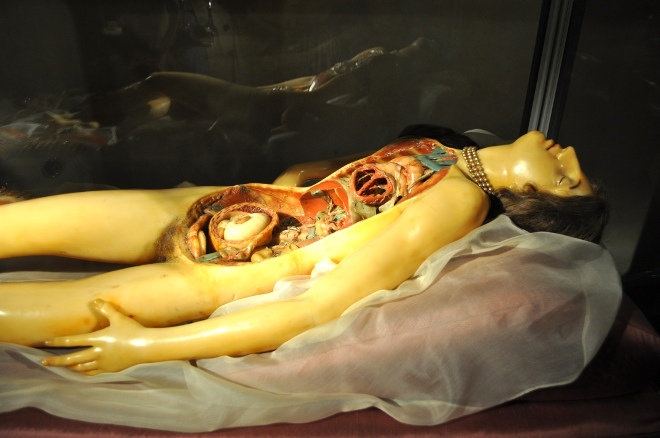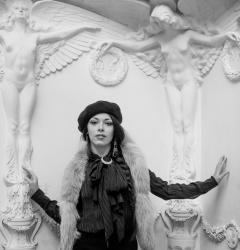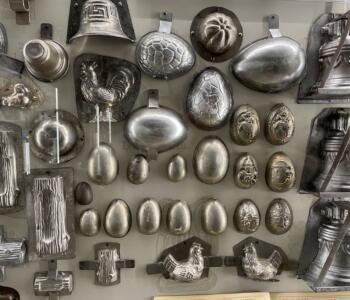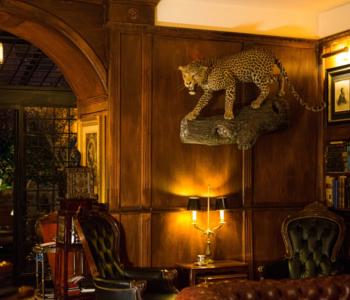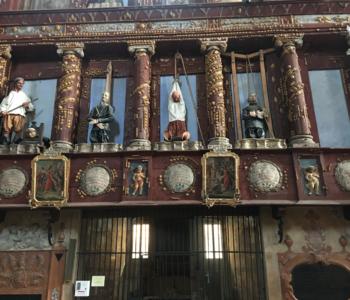
I know that this limbed woman could impress some of you, but her peacefulness is quite mesmerizing. She is what impressed me the most in the Palazzo Poggi Museum (Bologna), even if I had already saw another girl like this at La Specola, Firenze.
She doesn’t seem to be aware of her “nudity” and shows unconsciously all herself. Her expression remind me the ecstasy of Santa Teresa as it’s diffucult to understand if she’s dead or she’s just sleeping. Anyway, the artist who made her (Clemente Susini), didn’t forget to put a necklace on her, maybe a symbol of vanitas, and to give her a delicate beauty, the Beauty of Death. So this girl turn out to be not just a wax model, but also a memento mori. Placed in a room alone , this girl nicknamed Venerina, is the jewel of the museum, a kind of Sleeping Princess waiting for a kiss.
The Museum
The Palazzo Poggi Museum did not originate from collections accumulated over time. Its unique feature consists in being a re-composition of the laboratories and collections from the old Istituto delle Scienze, founded by Luigi Ferdinando Marsili (1658-1730), which was housed in the rooms of Palazzo Poggi from 1711 to 1799.
The Istituto delle Scienze was the first public scientific institution devoted to research and scientific education according to a methodology of direct observation and laboratory experimentation. Because of its state-of-the-art instruments and methodologies as well as the fields of research it pursued ranging from natural history, to archeology, chemistry, physics, astronomy, anatomy, mathematical and rational mechanical applications, the Istituto delle Scienze constituted a sort of “encyclopedia of the senses” for European scientists.
Additional attractions housed in the Institute were the Wunderkammer that belonged to Ferdinando Cospi (1606-1686) as well as Ulisse Aldrovandi’s collection (1522-1605). Another feature that distinguished the Istituto from other scientific academies was the artistic value of its setting. In fact Palazzo Poggi held the most prestigious 16th century paintings in the Po valley area, including mural paintings by Niccolò dell’Abate, Pellegrino Tibaldi, Prospero Fontana, Nosadella and Ercole Procaccini.
When the Napoleonic reforms were enforced for academies and universities, the extremely valuable assets of the Istituto delle Scienze were divided up among the laboratories of the different departments of the university. Later they became the historical core of the Accademia delle Belle Arti, the Museo Civico Archeologico and the Musei Civici d’Arte Antica.
In addition to making the rooms of the 16th century palazzo that during the 18th century had housed the Istituto delle Scienze accessible to the public again, in the Autumn of 2000 the University of Bologna restored the building to its historical functions. Rooms that for many years had been used as offices and storage spaces were returned to their original function as containers of 18th century scientific instruments, equipment and collection specimens.
ps: the fuzziness of the pictures is due to the lack of light and the reflections of the showcases.
source: museopalazzopoggi.unibo.it
more pictures on my flickr

The Luigi Ferdinando Marsili Collections
The Natural History collection was one of the highlights of the Institute of science in Bologna, as it successfully combined the “local” teaching and classificatory tradition dating back to Ulisse Aldrovandi teachings with the most recent European developments in the discipline.
The core of the collections consisted of natural specimens collected by military man and scientist Luigi Ferdinando Marsili (1658 -1730), founder of the Istituto delle Scienze, during his many trips in various European regions.
The assumption that nature operates within a framework of regularity, according to processes that are both necessary and gradual, was reflected in the different sections encompassing only natural objects and bodies. These specimens were arranged and classified according to criteria conveying a reliable image of the organization and function of nature. Given that naturalists were supposed to concentrate on “regular generations”, “series” of specimens became the core of the collection, while unique and rare specimens were considered secondary.
Marsili’s classification concept started with rocks, fossils and minerals and then proceeded to marine and terrestrial plants and ended with specimens from the animal kingdom. After 1750, new orientations held by Vallisnieri, Buffon, Charles Bonnet and L. Spallanzani influenced the naturalists and their later arrangement of specimens and materials.












The Museum diluvianum of the Istituto delle Scienze
Linked to the latest studies on the structure and age of the Earth, the debate about fossils was central to the scientific discussions in the first half of the 18th century.
Until one century earlier the scientific community had been discussing whether the “figured stones” were organic or inorganic in nature but in the 1700s scientists focused their investigations on the origins of fossilized organisms, how they occurred and how long it must have taken them to form. Supporters of the diluvial theory, including in Bologna the followers of John Woodward (1665-1728) and Johann Jacob Scheuchzer (1672-1733), claimed that fossils were the testimony and relics of the Biblical flood. Others, who were influenced by G.L. Buffon, in addition to the theses of A. Vallisnieri and Marsili himself, claimed that fossils resulted from gradual transformations of the earth.
The fossil collections of the Istituto delle Scienze named the Museum Diluvianum was arranged and classified by G. Monti and evoked the theory of the “Great Flood”. Vallisnieri suggested that the origins of the “fossilized” organism should be sought not in a sudden catastrophe but in the gradual outflow of sea water after a succession of floods.
The position that was shared by in large by the naturalists of the Institute, including Marsili and Ferdinando Bassi, did not argue against the biblical event of the Great Flood but at the same time did not consider it the sole cause of the modifications of the earth’s crust and the trapping of organic remains in its different layers.










The School of Obstetrics
Before the 1700s the practice of obstetrics had been in the hands of midwives, but in the 18th century there was a big effort to set the scientific grounds for the practice and turn it into a medical specialization.
In the course of the century, the art of childbirth became a subject worthy of being taught to surgeons and midwives. Giovanni Antonio Galli (1708-1782), a Professor in the School of Surgery of the University of Bologna, set up a School of Obstetrics at the Palazzo Poggi. There, the science of birthing was taught both to physician and to midwives according to a method devised by Galli himself. It included the use of three-dimensional wax tablets and clay models of the uterus as well as instruments such as the so-called “birthing machines” which simulated the real situations of gestation and childbirth.
With his teaching Giovanni Antonio Galli set forth an original educational methodology by which scientific knowledge and professionalism were achieved by the acquisition of both theoretical knowledge and practice. Together with the valuable equipment specifically developed for the teaching, it became a rare example for those years of a School of Obstetrics within a medical and surgical school.








Ercole Lelli’s Anatomical Waxworks
Ercole Lelli (1702-1766), “figure director” of the Accademia Clementina delle Belle Arti housed in Palazzo Poggi, was responsible for the first systematic planninginvolving anatomical waxworks. In October 1742, upon Pope Benedict XIV’s request, he presented his programme for the institute’s anatomical room detailing the wax model tablets he was to create. These included: wax tablets illustrating “separate bones”, eight life-size statues including a male and a female nude and six flayed men showing different muscle layers down to the bone.
The Camera della Notomia (The anatomy room) was finally instituted in the institute in 1747.
The making of wax models entailed several stages of preparation. The first step was procuring th body parts to be reproduced. At this point a drawing of the part was made and layers ol coloured wax were poured over it imitating the real body part.
The wax – generally the “Levante” type” – was diluted with turpentine and then blended with mastic and tallow. For the models, the base was generally made of bones taken from human skeletons, and in the case of full figures, they were supported by a steel wire framework that made possible setting them in the desired poses.



The plaster statue of the Flayed man, made by Ercole Lelli, is a scale model of the right-hand statue in the Anatomical Theatre of the Archiginnasio.

Morandi and Manzolini’s Anatomical Waxworks
For most of the 18th century Bologna was in the forefront in the reproduction of wax models of full human figures or individual parts of the body. After Ercole Lelli, the leading figures in this art were Anna Morandi (1714-1774) and her husband, Giovanni Manzolini (1700-1755), both of whom made very important contributions to the anatomy room of Palazzo Poggi.
Anna Morandi had been trained by her husband who, in turn, had collaborated with Lelli. She also made the wax obstetrics models for Giovanni Antonio Galli.
Morandi and Manzolini’s production are a testimony to the clear progress made by wax anatomical modeling as far scientific accuracy was concerned. Unlike Lelli’s productions, which were limited to bones, muscles and tissues, Morandi and Manzolini’s focus was on the study and reproduction of sense organs, the uro-genital and the cardio-vascular systems.
The tablets crafted for the anatomists at the institute provide an excellent example of Morandi’s skill in combining effective and elegant renderings with the most up to date findings in physiological and anatomical research.
In her unpublished Catalogo dei preparati anatomici (Catalogue of anatomical models), she provided very detailed descriptions of each body part represented and its function, often including her own scientific commentary.
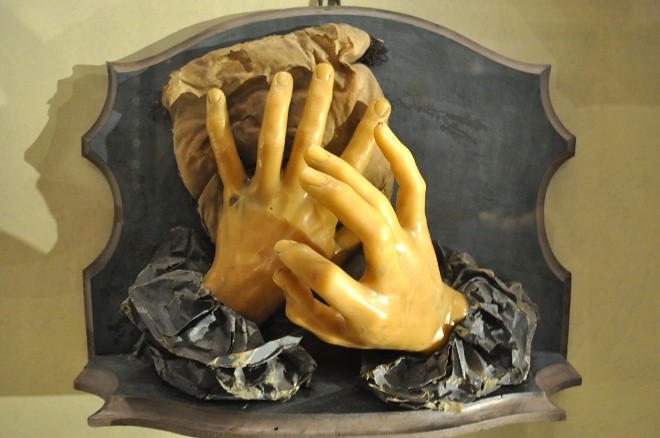
Anna, Morandi, Hands, wood and fabric, 18th century




The wax modeller Giovanni Manzolini touches a heart with his left hand, in this portrait by his wife.

Clemente Susini’s “Venerina” anatomical wax model
The Bolognese “Venerina” is one of the more or less faithful replicas of the original model, the Venere dei Medici, that Clemente Susini (1754-1814) made between 1780-1782 in Florence. The agony of a young woman is represented in her last instant of life as she abandons herself to death voluptuously and completely naked. The thorax and abdomen can be opened, allowing the various parts to be disassembled so as to simulate the act of anatomic dissection.
A virtual dissection, to be carried out by lifting the movable layers or ‘pieces’ to reveal veins, arteries and internal organs. A young woman, the Venerina carries a foetus in her womb – to suggest the procreative potential of the female body – despite the total lack of any outward signs of pregnancy.
The alienating effect that the statue produces by combining anatomical detail, crude and repulsive, with a harmonious and sensual litheness, is the result of a precise scientific choice: sensitivity is an essential quality of matter; sensitivity – with its wide range of manifestations, including the sensuality of the Venerina who surrenders herself to death – lies at the core of the physical and physiological organisation of man.

Electrical Physics
By the mid-eighteenth century the institute and the academy had long been involved in a sophisticated discussion about electricity. These concepts were further developed by Luigi Galvani (1737-1798). He conceived of animals, and by extension human beings, as having a unique electrical property, with the brain being the most important organ secreting “electric fluid” and the nerves being the organs with the greatest affinity with this unique electricity.
According to his theory, a substance inside the nerves specializes in conducting electricity whereas an outer substance prevents its dispersion. Muscles function as receptors of animal electricity, and, in this, the living organism resembles an electrical machine with its own energy capable of reacting, at the same time, to external stimuli. Motion is produced when the muscle fluid discharged from the interior to the exterior of the muscle through nerves provides electrical stimulation to irritable muscle fibers, which contract as a result.
Galvani’s ideas focusing on the study of electricity in relation to motion attracted the attention of the international community and paved the way for new fields such as electromagnetism and neurophysiology.



 Optics
Optics
In 1747 all the optical equipment made by Giusppe Campani (1635-1715), who had one of the most renowned workshops of the era, was placed at the institute’s disposal. It included finished lenses, bronze moulds to grind lenses and lathes to create the moulds. This finally made it possible to open a dioptrics laboratory, which had been requested by Marsili but never approved by the institute. The workshop was used both as a physics laboratory and to grind the magnifying instruments used at the observatory.
Action by Pope Benedict XIV also made it possible to purchase the equipment needed to set up a regularly held course in experimental physics, from Dutch artisans who had worked with van Musschenbroek and Gravesande.
Thanks to this donation, physicists were able to attempt a series of experiments that had been postponed due to poor or lacking equipment at the institute. Now they could use high quality instruments to study the composition of forces, the laws of elasticity, fluid dynamics and air compression, as well as precision thermometers and new hydrostatic and pneumatic machines.




Light
Starting from the early years of the 18th century, the experimental results achieved by Isaac Newton (1642-1727) and published in Opticks became terms of reference for the Bolognese physicists engaged in the study of light and colours. Francesco Maria Zanotti (1692-1999) and his student Francesco Algarotti (1712-1764), in the early 1720s were the first in Bologna to perform crucial experimentation on the Newtonian theory of colours, i.e., the double refraction of sunlight through an optical prism.
Since 2003, the same room in Palazzo Poggi where the experiment was performed has been housing a statuary replica of the experiment inspired by G. Pittoni and D G Valeriani’s An Allegorical Monument to Sir Isaac Newton (Cambridge, Fitzwilliam Museum). The beam of light reflected by a mirror and refracted by a prism clearly shows the spectrum of colours comprised by sunlight.

 The Library
The Library
The room of the first library at the Istituto delle Scienze, designed by the architect Giovan Battista Piacentini and completed in 1724-25. The globe is on loan from the Bologna State Archives (Vincenzo Coronelli, Terrestrial Globe, 1692-93).

